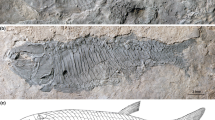Abstract
Recent finds1,2 demonstrate that internal fertilization and viviparity (live birth) were more widespread in the Placodermi, an extinct group of armoured fishes, than was previously realized. Placoderms represent the sister group of the crown group jawed vertebrates (Gnathostomata)3,4, making their mode(s) of reproduction potentially informative about primitive gnathostome conditions. An ossified pelvic fin basipterygium discovered in the arthrodire Incisoscutum ritchiei was hypothesized to be identical in males and females, with males presumed to have an additional cartilaginous element or series forming a clasper. Here we report the discovery of a completely ossified pelvic clasper in Incisoscutum ritchiei (WAM 03.3.28) which shows that this interpretation was incorrect: the basipterygium described previously1 is in fact unique to females. The male clasper is a slender rod attached to a square basal plate that articulates directly with the pelvis. It carries a small cap of dermal bone covered in denticles and small hooks that may be homologous with the much larger dermal component of the ptyctodont clasper.

Similar content being viewed by others
References
Long, J. A., Trinajstic, K. & Johanson, Z. Devonian arthrodire embryos and the origin of internal fertilization in vertebrates. Nature 457, 1124–1126 (2009)
Long, J. A., Trinajstic, K., Young, G. C. & Senden, T. Live birth in the Devonian period. Nature 453, 650–652 (2008)
Goujet, D. & Young, G. C. in Recent Advances in the Origin and Early Radiation of Vertebrates (eds Arratia, G., Wilson, M. V. H. & Cloutier, R.) 109–126 (Dr Friedrich Pfeil, 2004)
Brazeau, M. D. The braincase and jaws of a Devonian ‘acanthodian’ and modern gnathostome origins. Nature 457, 305–308 (2009)
Miles, R. S. Observations on the ptyctodont fish, Rhamphodopsis Watson. J. Linn. Soc. London Zool. 47, 99–120 (1967)
Miles, R. S. & Young, G. C. in Problems in Vertebrate Evolution (eds Andrews, S. M., Miles, R. S. & Walker, A. D.) 123–198 (Linnean Soc. Symp. Series 4, 1977)
Young, G. C. The relationships of placoderm fishes. Zool. J. Linn. Soc. 88, 1–57 (1986)
Acknowledgements
We thank M. Siverson for access to specimens at the Western Australian Museum. J.L. and K.T. are supported by Australian Research Council Discovery grants, and field work at Gogo in 2001 was supported by an Australian Geographic grant. P.A. is supported by the Swedish Research Council. K. Bifield prepared the specimen.
Author Contributions J.L. found WAM 03.3.28 and supervised the preparation, P.A. correctly identified the clasper, and all authors contributed to the description of the material.
Author information
Authors and Affiliations
Corresponding author
PowerPoint slides
Rights and permissions
About this article
Cite this article
Ahlberg, P., Trinajstic, K., Johanson, Z. et al. Pelvic claspers confirm chondrichthyan-like internal fertilization in arthrodires. Nature 460, 888–889 (2009). https://doi.org/10.1038/nature08176
Received:
Accepted:
Published:
Issue Date:
DOI: https://doi.org/10.1038/nature08176
- Springer Nature Limited
This article is cited by
-
The origin and early phylogenetic history of jawed vertebrates
Nature (2015)
-
Molecular development of chondrichthyan claspers and the evolution of copulatory organs
Nature Communications (2015)
-
Copulation in antiarch placoderms and the origin of gnathostome internal fertilization
Nature (2015)





